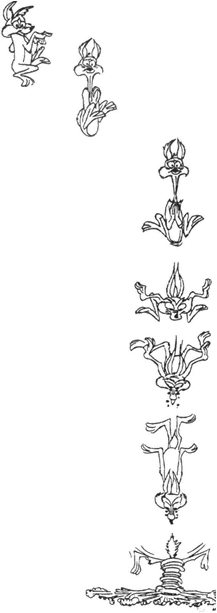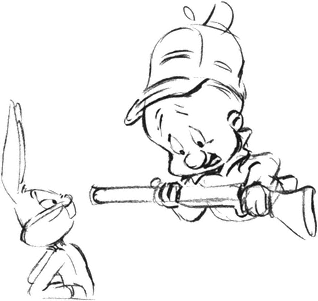Life in a Comma-Factory
Jack and Harry, the take-charge Warner brothers, were notorious for interfering with anything they thought they understood. Their malaise pertained to the profit margin on features, which tended to be thin and was easily violated by directors whose pretensions to "artistry" kept them fussing with angles and retakes while the clock ticked. Two minutes and a half of usable footage each day was a feature director's normal quota. Back before he bolted Warners for MGM (and The Wizard of Oz ), Mervyn LeRoy was valued for routinely doubling that.
Resources were dispensed as through an eye-dropper. The director of Emile Zola wanted a crowd of 400. Allotted just 200, he lowered the lighting to "rainy day" level and deployed 400 umbrellas, only half of which had people under them. The director of The Private Lives of Elizabeth and Essex was ordered not to let any sets be dismantled since their reuse in the upcoming Sea Hawk would "save a fortune."
Jack Warner, whom Fortune in 1937 called "a jocose penny-watcher,"[1] saw to it that Warner Bros. avoided co-starred features because those would mean paying two stars. In the pre-war decade when the house style was established, the Warners tended to concentrate on pictures one male actor—Paul Muni, Jimmy Cagney—could dominate. They preferred, too, darkness and fog, because sets you couldn't see didn't need constructing. An in-house memo of 1937—not from a Warner but in the Warner spirit—instructs a director not to "pump too much fog into the foreground in gusts." Artistic criteria? Fiscal? Uncertain. Around the same time, Jack Warner's attention was being mesmerized by the tint of Errol Flynn's mustache: "The mustache certainly looks good. I am sure that the mustache is the thing for this picture." (That was Lives of a Bengal Lancer .)
Mustaches after all came cheap, and "cut-rate dreaming" was the Fortune writer's phrase for the whole operation. He cited Harry Warner: "Listen, a picture, all it is is an expensive dream. Well, it's just as easy to dream for $700,000 as for $1,500,000."[2] (Meanwhile, over at the Disney dream-factory, Snow White and the Seven Dwarfs was running up a tab—for a venture in animation!—of more than the million-and-a-half that gave Harry Warner shudders at night.)
[1] Someone less tactful once said Jack's suits had rubber pockets so he could steal soup.
[2] In 1937 dollars, of course. For an early-90s equivalent try multiplying by about 10. And that's just to adjust for inflation. Today's overhead—color, special effects, union scale boosts—costs easily another fivefold. So in the 1990s animated features were enjoying a comeback after decades of eclipse. However labor-intensive, they were actually cheaper to make than damn-the-budget live action.
Warners, by the early 1940s, owned 17,000 movie-houses in 7,500 towns, a total of 10,500,000 paying seats. Keep filling those seats, was the word that went to directors. And every fortnight, preferably oftener, went the word to Termite Terrace, We need one snappy new cartoon.
Yet, whatever horror stories linger in veterans' memories, Termite Terrace, unlike any other Warner Bros. division, ran with a singular minimum of interference. So complex was its operation, you might have expected an accountant's face at every transom. But no. And why not?
For one thing, the Warners didn't own the place till as late as 1944. They simply bought its product from Leon Schlesinger Productions. And after they took over, and installed Eddie Selzer as boss, though Eddie was a bore and a nuisance the Brothers seemingly weren't. Jack Warner's recorded interferences, though catastrophic, were but two: when he closed the studio briefly in 1953, then for good in 1963. Beyond that, the indifference does seem out of character. But look, the cartoon division wasn't important. That may well be an explanation.
For examine something else that's unimportant. I press a key. A comma appears on my computer screen. Now how did that happen?
Even at its simplest—on an IBM desktop machine—the sequence is unbelievably intricate. That key closes its unique combination of circuits. Next, a keyboard microchip, prodded to do something, wakes up. Checking the active circuits against a list, it emits a "Scan Code"—comma! The code goes to an Interrupt Service Routine, which is contained in a Device Driver, which has seven subsections you don't want to hear about, all essential to handling that tiny Scan Code. Like
phone girls and file clerks guarding an Executive Producer, they cater to the whims of the Boss Microchip, the Central Processing Unit. It's possible, for instance, that the CPU may have other things on its mind which had better not be violated. So, clear its desk! And fourteen separate items, which may or may not be important (but you never know), get squirreled to safety by a head flunky, just to free high-level attention for the incoming comma. And now (music up!) the Scan Code can be ceremoniously placed in a sacred area called the Data Buffer. Only after that does the CPU get its fourteen items back so it can go on with its deliberations if it has any. What happens next depends on whether, when I pushed that key, I was running a program or just doodling. If a program, well, it's still more complicated. . . . But the Data Buffer is retentive, and eventually (we're counting in milliseconds) a little comma does emerge from its entrails to show up on the screen, while thousands cheer.
The sequencing of events at Termite Terrace, to generate a cartoon every ten to fourteen days, was at least as convoluted as that. The point of the parallel is that no one cares how a comma hits the screen so long as it gets there. Fast. And no one at Warners seems to have cared, either, how a cartoon got to 17,000 screens, so long as it reached them on schedule. Life at Termite Terrace was, blessedly, Life in a Comma-Factory. The product? Merely a punctuation mark, just before the two-reeler that came just before the feature. And the moral is, What Freedom!
By about 1949, the beginning of the Chuck Jones Golden Era, several economies had long been installed. Each, in the Warner spirit, ought to have been a hobble. At Termite Terrace each was a liberation.
First, how much footage? Cartoons ran about 7 minutes.
At 420 seconds, that's 10,080 frames, or 5,040 drawings when we shoot each of them twice. A lot of drawings. Even at starvation wages, a lot of money: say $30,000 per Looney Tune: say three-quarters of a million bucks annually, plus change.
That's about the cost of one middling 90-minute feature; and for about twice the delivered footage per year! Foot for foot, Termite Terrace might seem a bargain.
Still, it's features, not cartoons, that draw the crowds. Cartoons being trivial, something seemed out of balance. Seven minutes per product: might exhibitors stand for less? It turned out they'd regard five minutes as short weight. The compromise was six; six minutes plus or minus a grotesquely specified two-thirds of a second. Standardization #1: Scale as fixed as the size of a window at Chartres .
Next, we've got to get this place organized. Every two weeks, that's twenty-six a year; three directors can handle that, each responsible for about ten films. From conception to delivery, a cartoon might take twelve months or more. So a director at any time had ten or more going at once, the newest just being talked out, the oldest acquiring its sound track, perhaps eight others in stages of gestation. Thus, Standardization #2: The picture belongs to the director .
That system was firmly in place by 1944, when the Warners bought Schlesinger out. By 1947 the three directors were Isadore (Friz) Freleng, Charles Martin (Chuck) Jones, Robert (Bob) McKimson. And the control of each, over each project credited to him, was, finally, absolute. Termite Terrace being the only shop where so rigid a system was installed to meet so exacting a schedule, the Warner Bros. cartoon division was likely the only place in all of cinedom to which the auteur theory can be rigidly applied.
Auteur is what the French call an author, a creator; and auteur theory was something film historian Andrew Sarris began promoting about 1968, to celebrate, as his gadfly Thomas Schatz puts it, "the director as the sole purveyor of Film Art in an industry overrun with hacks and profitmongers." Schatz calls that "adolescent romanticism"; his The Genius of the System (1988) is persuasive about hacks and profitmongers not sabotaging good films, but imposing the limits that made good films possible. For art is largely an affair of limits. When the Medici asked for a panel of certain dimensions to adorn, as it were, their summer cottage, that was when they got Botticelli's Venus .
Schatz, though, nowhere mentions the cartoon operations maintained by the studio systems he surveys: a pity, since the reason we have such a book as Steve Schneider's That's All Folks! (subtitled, The Art of Warner Bros. Animation ) is that the Warner system, albeit by inadvertence, guaranteed a niche where miracles could happen: where "Art," an overused word, is fitfully applicable.
And the time has come to demystify the Termite Terrace usage of "Director." The DeMille image—bawling through a megaphone at actors—is inapplicable; there was no Bugs Bunny to bawl at, save as numerous pencils created him at the rate of twelve drawings per second (every frame shot twice, remember?) Over at Disney, to say that Art Babbitt supervised one of Fantasia' s highest points, the Chinese Mushroom Dance, or that Shamus Culhane marched the Seven Dwarfs off, Heigh Ho, is to say we don't know what we're saying, since (as Jones remarks) the head animator of a Disney sequence worked with a sequence director, who in turn had the privilege of consulting the film director, who might consult
Walt. Also, Walt might just drop in. So we can't tell when or how often Walt may have been involved. Walt, a mediocre animator but a storyman of genius, had the last word on every detail and would order things redone from scratch. At Warners they didn't enjoy the luxury of redoing. Just get it the way it's going to be, the first time round.
Hence the Director's necessary iron control. Briefly: he confabbed with the storymen, he worked with the soundmen; he knew the strengths of his key Animators; he knew their In-betweeners. He drew "Model Sheets" to help numerous hands keep his characters unified. (Jones's Bugs isn't Freleng's Bugs.) And his crucial role came down to (1) making 300 or up to 500 key drawings to guide the Animators; (2) making frame-by-frame plans called Exposure Sheets that would bring the thing out exactly on the last second (360 seconds, that's 4,320 drawn frames, give or take a half-dozen.) With ten or twelve projects under way on any morning, the director might be shown one of up to 50,000 drawings, by some underling in a jam. Unflappable, he'd recognize its place in which sequence of which film. Such talent was rare, the knack for those key drawings rarer still, command of the Exposure Sheets likely rarest of all. Great as the best Warner Animators were, it's no wonder so few became Directors.
Chuck Jones tended to make more key drawings than the other directors. They show how a sequence of movement is to begin and end. He's explicit about their role. The Animator wasn't to trace them. The Animator was to use them as guides, defining a flurry of drawings he could feel happy with. "Ken Harris will change everything. He'll use an idea, but the action will flow through and go beyond it. Or he may forget it completely. But his animation will indicate what I
had in mind." One facet of directing is prodding the very best out of such a rare talent as Harris's.
(And the In-betweeners? A hack In-betweener, as the art had evolved by the era we're speaking of, might as well be computerized—something that's still being worked on—but a good one, moving toward Animator status, understood how between key frames different parts of a creature shift different weights at different velocities. As the foot comes to rest, the body still lurches forward. Great animators insist that there is no such thing as an exact in-between, equidistant between extremes. So cherish your In-betweeners, who generate possibly 80 percent of the frames that end up, inked and painted, on-screen.)
The Animators also kept a wary eye on the director's other principal offering, the Exposure Sheet. It's a printed strip of sturdy paper, about nine inches wide by twenty long, ruled with a horizontal line for every frame, plus emphatic lines for feet of film, seconds of time. Every drawing we're going to generate gets accounted for there, every footstep, drumbeat, syllable of dialogue. No live-action auteur could have dreamed of such command. And each sheet takes care of 6 feet. So 540 feet of film—6 minutes—means 90 of those sheets, a thickish stack.
Bugs Bunny is walking 12 paces per foot (at 12 drawn frames per foot, that's a second per pace). Down the left-hand column, "Action," an X at every 12th line means a foot touching ground; key drawings will guide the Animator there. And Bugs is saying (what else?) "What's up, Doc?" In the next column ("Dialog"), at frame 8, the "Wh" commences (his mouth starts to open); by frame 16 his mouth is wide open on the "ah"; by frame 22 it's closed on the "ts." That kind of thing is plotted on the Exposure Sheet for every syllable of
dialogue; the mouth-closing "c" that ends "Doc" coincides with frame 52 (drawing 26). The rule is that sound can escape the mouth only on vowels, consonants determining the beginning and finish of the vowel sound. On M, F, P, the mouth closes. On T, N, L, the tongue goes up against the roof of the mouth. Such are the instants the director needs to locate for the Animator, so the timing of dialogue will flow aright. Between such key points, a competent Animator is on his own. At Warners they had some very competent Animators.
Jones can tell, he says, if timing is off by one frame. That's less than an eyeblink. Prescriptions could be unbelievably precise. When the Coyote dropped off the cliff, as he did repeatedly, it would take, says Jones, "Eighteen frames for him to fall into the distance and disappear, then fourteen frames later he would hit. It seemed to me that thirteen frames didn't work in terms of humor, and neither did fifteen frames. Fourteen frames got a laugh." And from the Exposure Sheet all hands—Animators, In-betweeners, Sound Crew—knew exactly what was required.
But there's more. In addition to a wide rightmost block headed "Camera Instructions," where you'd specify, say, panning the next forty frames across a wide background, the Exposure Sheet has six more numbered columns. Those are for any special high-jinks with cels. Because if Elmer Fudd holds still and just moves his lips to say "Wabbit season," the main Elmer-cell, to save a lot of redrawing, can just be overlaid with a sequence of mouth-cels. You might find yourself repeating that principle for several layers, trusting someone in Ink-and-Paint to remember that colors change when they're perceived down through overlaid cels. To keep Elmer's red jacket Elmer-red beneath three cels meant calling for a richer red with a special number.
And let's attend anew to one phrase: "to save a lot of redrawing." If that began as a concession to the cash-register, it soon became a principle of art. Recall Gertie the Dinosaur, of pre-cel days, when endless retracing made everything shimmer and wobble. But cels let us think of shimmer and wobble as special effects. Special too is the non-wobbling rigidity of drawings simply reused. So as animation evolved post-cel, just what changes now becomes what matters, to offset what—for two seconds (eternity!)—isn't changing. That gets emphasis Animators can get in no other way: think of Elmer's obsessed rigidity as he listens for wabbits. Maybe eyes blink (overlaid cels); maybe they don't. Selective redrawing became, especially at Warners, one of animation's subtlest modes of expression. What the Termite Terrace zanies found in it resembles Milton's discovery, circa 1660, of the range of effects blank verse on a printed page could extract from a mid-line pause: Line visible, stable; Pause audible, fluctuant.
What that does is throw emphasis back on the key drawings: the moments of stasis, of expressive posture, which might even stay frozen for several frames. At Disney the emphasis was on fluent movement; at Warners, the prolific Friz Freleng's habit tended that way too. It was during stretches of dialogue that Disney's custom was to introduce punctuating pauses, where they can be subtly irritating simply because they're meaningless. But Chuck Jones cherished the summarizing key pose, and his Exposure Sheets were apt to instruct that it be held: held an exact number of frames. And of such was his kingdom of heaven.
Generally, as a cost-saver, the largest number of characters visible in one shot was two.[3] Thus in the Hunting Trilogy of 1951–53 (Rabbit Fire; Rabbit Seasoning; Duck! Rabbit! Duck! ), though each film revolved around three characters—Elmer Fudd, mighty hunter; Bugs Bunny, cool evader; Daffy Duck, hysterical victim—the economical strategy was to establish their relationship, then resort to "one-shots" and "two-shots." And the two-shots could economize too, by just "looking at one of the characters" without troubling to animate him. Thus, "Daffy would say, 'Oh, no you don't,' and Bugs would just stand there waiting. Because that is what he would do anyway." Chuck Jones guesses that in a given picture, perhaps 60 percent of the shots use just one character. "We soon learned that it was not just to cut down on the number of separately animated cels, but to emphasize the power of a strongly-drawn non-talker as a foil for the voluble. It became what I call Motivated Camera. Having established the rhythm of the relationship between two characters, I could go to one for something to say, go to the other for the reaction. We learned to do it pretty well." Indeed they did. Something from the Hunting Trilogy tends to show up on most lists of Warner cartoon highlights.
An economic necessity, true; but there's no denying how, here as so often, necessity "resulted in far better picture-making."
And for another interesting reason: "It also resulted in our cutting all the fat out of our dialogue. I mean, if you have something to say, say it. You know."
[3] By contrast, there are scenes in Snow White where as many as thirty animals are all differently busied. But cost wasn't governing such scenes.
And to show that I knew, I volunteered, "Get the meaning across and then stop."[4]
And Jones, good liberal that he is, responded with "Woodrow Wilson, I think it was, who said, If you're shooting, do not use a shotgun, use a rifle with a single bullet; likewise when you're writing." That's the one time I've heard an ex-president of Princeton cited as a monitor of verbal style.
One can hardly overestimate the extent to which the Warner Cartoon Style stemmed from the need to minimize costs. "If I had suggested doing 101 Dalmatians everyone would have thought I was crazy. Even a dog named Spot, with one spot, would have been out of the question. What costs in animation isn't colorful and detailed backgrounds; those are its cheapest elements, because a short with maybe 65 backgrounds will still need 5,000 drawings. It's the details in those drawings that cost. When Disney made 101 Dalmatians, the animators didn't animate dalmatians, they animated white dogs. Somebody else came along and put the spots on. O. Henry said that the most exacting (make that 'exasperating') job in the world was that of foreman to a gang of invisible weavers. I'm not so sure."
And they kept the spots consistent on each dog?
"No, they animated just eight different dogs. That was the first time they used a computer, for the few scenes when you see the whole pack of puppies at once. It decided how to randomize eight dogs repeatedly so that 101 of them running at you would look like 101 dogs rather than a dozen-plus sets of eight."
[4] From Ezra Pound's Cantos, where the sense is attributed to Confucius.
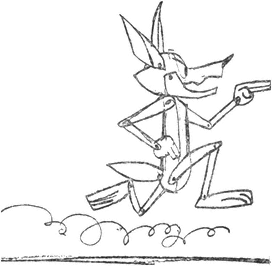
Limited animation
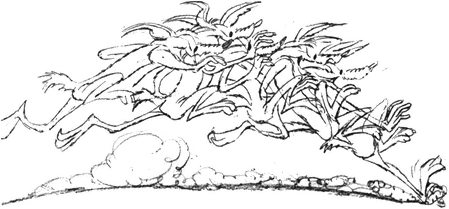
Full animation
Ramifications of the need to economize are not, alas, infallibly benign. Saturday morning television would bring about what the film critic Leonard Maltin calls the Muzak of animation.[5] Chuck Jones once summed up what he calls it in one
[5] Film Comment, January–February 1975, p. 77.
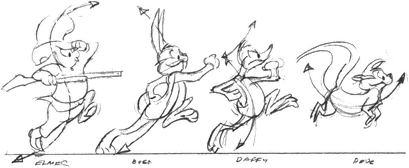
savage drawing. He also adduces what Groucho Marx called TV: "The chewing-gum of the eye." But defenders have a cushion-word, "limited," and Limited Animation even gets touted as an artistic discovery, perhaps because UPA's stylizations of the '50s, partly derived from The Dover Boys, resembled it just enough to bemuse the hasty.
Limited Animation stemmed from the fix Bill Hanna and Joe Barbera, creators of the Tom and Jerry duo, found themselves in when their twenty-year connection with the MGM cartoon department was terminated with a phone call in 1957. That was when all the studios were getting out of animation: too much expense, too little return. (Newsreels were out; so were shorts, not to mention cartoons; the norm was becoming a Continuous Performance of maybe a single feature or maybe two.) Hanna and Barbera moved to TV, where they discovered that their MGM quota, 50 minutes of film a year,[6] had jumped up to over an hour a week. You can see what that dictates: as few different drawings per film as possi-
[6] That means, seven cartoons a year, each seven minutes. "Rich kids," comments C. J.
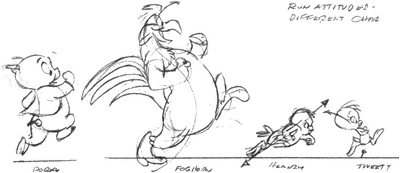
ble, which means, Maltin notes, that "all action takes place on the same plane"—no camera movement in and out, so a walk can just be the same few frames woodenly repeated. Also, no "tedious detail"; which means, says Maltin, that "wriggling an eyebrow would probably throw off the budget for an entire series." And every character walks like every other character, so out the window goes the very essence of Character Animation, which (remember?) defines a character by ways of moving.
"They blink when someone's talking," says Chuck Jones. "That's big stuff. To establish that the character is alive. What you have is two eye drawings, one closed, one open. And you leave the closed one on for eighteen frames." (There an expert eye has spotted the convention—a three-quarters-of-a-second blink.) "Or you have a whole bunch of people running, and you cut at the waist so you don't have to move the legs. And nobody moves off into the background or comes forward, because that takes a lot of drawings. Everything parallel to the camera, the same eight drawings over and over."
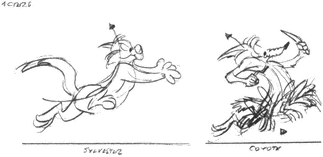
That leads him to a richer theme: "We never, in all the years I was at Warners, repeated the same run for Bugs or for Daffy or any other character. Never. I always felt there was something different in the character's mind. So the animators had the pleasure of trying out a lot of runs. They knew there is a lot of difference between running when you're being chased and running when you are chasing. And there's also a lot of difference, as in the Pepé Le Pew pictures, between running out of desperation, as his paramour is doing, or running out of joy, as he is doing. He didn't know what desperation was."
Pepé's most joyous run is modeled on the pronk, a word devised in South Africa a century ago to denote the springbok's vertical leaps. (It's from the Dutch pronken, to strut.) In Chapter 8 of their Fearful Symmetry: Is God a Geometer? Ian Stewart and Martin Golubitsky list pronking, "all four legs moved at the same time," as the least frequent of the eight main quadupedal gaits. It's uncommon, they remark, outside of cartoons (as they illustrate with a Garfield panel), though "sometimes seen in fast-moving deer." The Pepé pronk is a sequence of ecstatic vertical leaps, all four feet leaving the

ground at once, forward movement perhaps half of vertical, eyes wide, tongue lolling, the whole danced to a dream-tempo metronome that's wholly decoupled from the panic of any springbok. It's contemplative, and what its contemplation postulates is leisurely future bliss, untarnished by any cynicism about Jam Tomorrow but never Jam Today. Character Animation: so much can inhere in a way of moving.
One more thing: after 1944, directors dealt with producer Eddie Selzer, who always demanded to see scripts and never grasped that there weren't any (cartoons are storyboarded, not scripted). They learned to take a 180-degree turn from any judgment of Eddie's. "Bullfights aren't funny." Hence, Bully for Bugs, which Jones once called "The ultimate Bugs Bunny film."[7] And skunks talking French weren't funny? Voilà! Pepé Le Pew (who won an Oscar, graciously accepted by Eddie). Schlesinger, Jones remarks, had seldom even the energy required to say No, whereas Selzer said little else.
Something Eddie Selzer once found especially unfunny was four or five grown men laughing out loud over a story-
[7] As for getting Eddie to pay for the crew's fact-finding trip to Mexico: "He didn't; and he subtracted the time from our vacation allotment."
board. What the hell, he wanted to know, did all this laughter have to do with the job? (His tiny eyes, Jones recalls, were "steely as half-thawed oysters." Those are eyes perceived by an animator's eye. Eyes become steel becomes oysters. The stuff of animation is metamorphosis, and its theoretician ought to have been Ovid.)
So now you've an idea of what it meant to be a cartoon director. Are you relieved not to have been one? In a quarter-century Chuck Jones, if I've counted correctly, directed 204 Warner Brothers cartoons. A handful are masterpieces of the art. Abstractly remote from what an audience will see, Directing is a difficult process from which to wring masterpieces. "I didn't do it for kids," Jones has said more than once; "I did it for myself."
He's been called the most gifted animation director who ever lived. As he likely is. But in no area has civilization ever been a one-man job. Consider (1) that he'd not have had such an opportunity save at that one studio, where every pinchpenny gesture chanced to broaden the director's scope; (2) that sheer serendipity surrounded him for a few years with an incredible constellation of talents, all eccentric, as for good animation they'd best be. Michael Maltese, writer; Maurice Noble, background designer; Ken Harris, Benny Washam, and Abe Levitow—to name only three—animators; Carl Stalling, music; Mel Blanc, voices; and more; and rarely do such frenzies converge. (When Mel Blanc died the same week as Laurence Olivier, someone asked what production God might be pondering for Heaven.)
A fistful of dice, and every throw came up boxcar.
Maltese, to start with; "writer," though he'd write no words till it came time to suggest dialogue. There was never, as
Eddie Selzer couldn't grasp, a script. There was a "storyboard," four feet by eight, that ended up holding some 150 sketches. These graphed the course of a six-minute picture. The writer (who couldn't really draw)[8] and the director (who really could) put them there in the course of some five weeks' interaction. It had started from an "idea" (generally the writer's), such as "A male rabbit singing Brünnhilde's role against a mighty eighty-piece symphony orchestra." (That one led to a masterpiece: What's Opera, Doc? )
The mind of Maltese teemed with swift incongruities. The day he rode a wobbly elevator, his instant response was "Good to the Last Drop." Unlike Tedd Pierce, his predecessor on the Jones Team, Maltese had rather a gag-man's talents than a narrative architect's; compare Pierce's The Dover Boys, with its stress on an overarching plot, with any Maltese Road Runner, essentially a sequence of perhaps six major gags.
The storyboard's centrality, by the way, underlies a frequent Jones dictum: that any cartoon you can follow by ear without looking is merely "illustrated radio." Real animation holds you even with the sound turned off. Its kind of story, whether plot or gag-train, had to be planned via sketches—"dealing with graphics, not adjectives, from the start"—and the process seemed to take almost a week per minute.[9]
But five weeks' work might not lead anywhere interesting. To head off that danger, a "Jam Session" would be convened after week one. It included all three directors, their three writers, others, and the ground rule was that no one might say "no." Impart further spin to the ball, or else stay
[8] Though Maltese about 1938 did time as an in-betweener.
[9] Hereabouts, I find among my notes, in C. J.'s hand, "O. Henry once defined a character as about the size of a real estate agent. Now there is a provocative stage direction."
quiet. Within a half hour, much silence might suggest that the "idea" just wasn't working. Otherwise, two hours of creative input: from writers, and from directors (Freleng, McKimson) who knew that their next Jam Session would be profiting by input from Mike Maltese and Chuck Jones, just as Chuck and Mike would expect—and receive—wholehearted support from Freleng, Foster and Pierce.
(Hard to keep all these balls aloft; you're staying aware, yes, that on any day each director, each writer, was at some stage or other of maybe a dozen projects? How they concentrated on a Jam Session defies imagining.)
Next, Maurice Noble, Background Designer; and why do we need such a Designer? Well, while everyone else is minding masses of detail on a fractions-of-a-second scale, somebody has to be thinking of what the audience will see: a six-minute whole punctuated by notable details. The total look of the picture is what will contain their attention. This one is a murky film; this one is crisp; the audience won't think that way, but that's what they'll respond to. Noble, who'd done backgrounds for Disney's Snow White and parts of Fantasia, notably the Mushroom Dance, was to work with Chuck Jones for twenty years. His responsibility was for overall look and feel.
At Warners he didn't paint backgrounds, but his designs guided the people who did. Jones has described how their collaboration worked. "What I did was draft a very rough plan, just to show the layout man what I wanted. If I put in a doorway, all I wanted was room for the character to exit; I didn't care what the doorway looked like. Maurice would take my layouts—let's say there'd be ten layouts for the scene—and make a sort of mise-en-scène that defines the limits of the character action. He'd find the layout that goes the
furthest to the right, the one that goes the furthest to the left, the deepest one, the closest one, and generally plan where most of the action would have to fall. He'd take all these separate layouts and put them all in one drawing, and then design the background around it. He'd also take into consideration what was happening in the story—which very few background men ever do. Generally speaking, the foreground characters were all mine, but Maurice would also often design background characters which were visually very strong, like those Baroque-looking French bystanders in the later Pepé Le Pew cartoons."[10]
Noble had a lot to do with specifying colors, often against the resistance of the ink-and-paint crew. ("Do you really want this red next to this red?" "Yes." And, Noble likes to recall, "Chuck would back me up.") For the ballet sequence in What's Opera, Doc? he moved areas of flesh tint into the backgrounds, to make up for the unfleshly grayness of the prima ballerina, played by Bugs Bunny in drag. He also made sure that in the opening frames the shadow Siegfried/Fudd cast on a mountain's face would uncannily recall the "Chernabog" Devil in Fantasia (a prime feat of animation, by Disney's Bill Tytla, to which Termite Terracers more than once alluded). And for Duck Dodgers in the 24 1/2 Century he devised a spaceport so realistic, post-Apollo, it's hard to believe it dates from 1953, when Cape Kennedy hadn't been dreamt of. "Chuck would back me up" because Chuck held that a director who attempted his own designs, like the lawyer who pled his own case, had a fool for a client. And Chuck would also judge, in 1975, that of the people he'd ever worked with Maurice Noble was probably the most influential.
[10] Interview in Film Comment, January–February 1975, pp. 28–9.
Mel Blanc, finally: "Voice Characterizations," as the credits always said. And here was someone whose contribution, delivered in real time, on a live mike, could not be fiddled with the way you might fiddle with an in-between drawing. Mel might do it over and over, but what was finally used wasn't something you'd achieved by editing, but something Mel had done . (Not that technicians hadn't altered pace and pitch electronically while Mel did Porky or Tweety.) Mel could be Bugs one moment and Elmer Fudd the next; but the way it was really achieved, he'd record the Elmer Fudd speeches while Chuck Jones fed him the Daffy Duck outrages, then the Bugs dismissals while Chuck fed him what Daffy had been outraged by, and so on and on. And, Chuck Jones recalls, they'd stop doing that whenever Mel Blanc had recorded the same speech three times. (Thereafter, it's implied, live performers tend to deteriorate into rote.) But if Chuck wasn't happy with any of the first three recordings he'd sometimes suggest to Mel that he, Chuck, had perhaps botched his feeder-speech, so might they try it again?
And that is, more or less, how it was done: how the miracles were achieved, right through the Golden Age: from the mid-'40s through the mid-'60s.
We've been describing a team that had come together by about 1949; a convenient date since it happens to be the year of the first Road Runner film, Fast and Furry-ous . But by then, good lord, Chuck Jones, 37, had been Supervising, as they once called Directing, since March 1938, when he was a mere 25. That was when Frank Tashlin had just left Warners, and young Chuck, who'd been animating for Tex Avery, became his emergency replacement. How scarce experienced talent must have been! Walt Disney had brought a bunch of "experienced" youngsters westward by about 1925, the year his
Kansas friends Harman and Ising joined him in Los Angeles. And Jones's colleague Friz Freleng, for heaven's sake, born 1906, thus a mere six years Jones's senior, had been one of Disney's Kansas City migrants; which means that by the late '30s, when Leon Schlesinger was being hard-put to get a staff together after Harman and Ising left him, the people who'd been around animation long enough to know what they were doing, yet weren't so firmly established as no longer to be for hire, were all of them still conspicuously young. A 25-year-old director, name of, ah, Jones? To which an answer would be, O.K., find us someone more plausible. It was very much a young person's game. If, by today's standards, work often got crudely done, still the right young person, under pressure, might learn the Whole Art fast. And that diagrams the story of Chuck Jones.
So "I had to learn the language, and so did my animators. We had classes—for years we had at least two classes per week, at night. And we were working a five-and-a-half day week, about fifty-six hours a week."[11]
And, about Good Night Elmer (1940), "The story was just a tiny thing: a man attempting to put out a little candle. How can you make an entire story about that? Is it possible? That's what I wanted to know. I wouldn't say it was a particularly successful picture; but it was crucial in terms of what came afterward." The Beck-Friedwald entry on that film ends on a note of unaccustomed anguish: "One of the most irritating cartoons ever made. There was no reason to animate this, everything in this cartoon could have been easily filmed in live action. Chuck Jones's early super-slow timing at its most
[11] Again, Film Comment, January–February 1975, p. 22. This whole interview is a prime source.
brutal (hard to believe that this man would later make the super-speed Road Runner cartoons). And Elmer is so stupid it's painful!" Good Night Elmer is not a film I've seen; I'm simply reporting. But I'll draw attention to Jones's "Is it possible?" and the perhaps implied answer, No, not with the resources the director could bring to it at 28. We've likewise alluded to his long Disneyfied period. Well, think of that as more learning. And reflect that the breakthrough Dover Boys was achieved when he was just 30. (And by then he'd been directing for fully four years: had directed all of forty films. That amounts to some four-plus hours of screen time, the Director held accountable for every one of a dozen drawings per second. That in turn implies a lot of learning.)
One principle he learned is that believability is more important than realism; also that one thing that helps the animator achieve believability is a sense of what his characters weigh. Yes, weigh . It's clear from his manner of moving that the bull in Bully for Bugs (1953) is enormously heavy. Likewise, it's evident that when Willis O'Brien, the puppet-master of the original King Kong (1933), moved his furry eighteen-inch tabletop ape, he was guided by a very clear sense of how much sheer bulk the muscles of the "real" or fifty-foot Kong would be wielding. And it's equally evident that the special-effects gang on the disastrous Dino di Laurentiis remake (1976) didn't know how to keep us from detecting the sequences that were shot with a man in an ape-suit. And how do we spot them? Well, no one thought to tell the actor to keep his head and shoulders level as he walked. The way he bobs, we know at once we're looking not at multiple tons but at a routine Hollywood beach-bum.
Weight and how we assess it: that's one of Chuck Jones's most eloquent topics. Some of its ramifications are far from
obvious: "A cat," for instance, "is built light, but walks heavy." That means, the cat's spine stays a steady distance from the ground, which is what people who say a cat "slinks" are really reporting. A dog even twice the size of the average full-grown cat will likely have a bouncier gait. One wonderful Jones cartoon called No Barking (1954) is based on a careful contrast of such mannerisms. A puppy named Frisky bounds about, full of himself, as though nearly weightless; an alley-cat named Claude is driven half mad every time such bouncing and barking impinges on his own weighty languor. Claude will never be convinced that he's not the target of malevolent persecution, or that Frisky is, by and large, unconcerned about feline presence. What is making Claude's life unliveable, and will ultimately send him out of animation's universe, clutching in panic to the underside of a transcontinental jet, is both abstract and profound: not alien hostility but an alien rhythm . In one memorable sequence Claude is stealthily approaching a treetop nest, when a bark from Frisky sends him hurtling skyward past the nest and its resident, none other than Friz Freleng's Tweety in a two-second cameo appearance: "I tawt I taw a puddy tat." True. Frisky's rhythm in the universe of Claude is cause for alarm, though not for Tweety but for Claude.
No Barking illustrates something else Jones often comments on, the central importance of teamwork in a successful animation venture. As Beck and Friedwald remark, that film is devoid of human characters to supply framing dialogue; in fact, the seven words we've just quoted are exactly all the words Mel Blanc got to voice in the entire film. So absolutely everything has to be communicated via styles of movement; and "Jones relies exclusively on the studio's great animator, Ken Harris, to do the whole cartoon." That was possible be-
cause Jones and Harris had spent years negotiating a sense of one another's habits and conventions.
"The team thing is very important," Jones told the Film Comment interviewers.[12] "It gets to the point where you can snap your fingers, or make a single drawing to convey your idea. Whenever a new animator came to work for me, he was in trouble for a while, because on my exposure sheets, I would put down a notation like 'BAL'—which was 'balance'—or 'ANT'—'anticipate.' And all my animators had to know exactly what they meant." And what did they mean? Well, ANT was "an anticipation before the actual motion," while BAL "might mean that I'd want a particular character solid on his feet before he did something, so you'd know there was a stability to the thing, before it moved into action." It's evident how both BAL and ANT play on what we can be induced to expect we'll be seeing in the next few seconds. Part of our attention is now, part's in the future. Also, "When I put down a twelve-frame hold, that didn't mean thirteen frames or eleven frames, it meant twelve frames exactly. When the Coyote fell off, I knew he had to go exactly eighteen frames into the distance and then disappear for fourteen frames before he hit. A new animator would come in and he would overlap that, and it would never work." (Eighteen frames—that's exactly three-quarters of a second. Something beating at an eighteen-frame rate would throb seventy-five times per minute. And that's as close as cinema technology can come to the pace per minute of a "normal" adult heartbeat, which is seventy-two. Hmmmm. A hidden Law of Nature? What "works" on-screen is what corresponds to a pulse-beat?)
[12] See Film Comment, January–February 1975, p. 23.
And the many moods of the amorous skunk Pepé Le Pew—most of them upbeat—are conveyed by his many gaits, notably the frisky pronk that carries him round in circles of ecstasy, all four feet leaving the ground at the same instant. A quality almost dream-like inheres in the lift he gets.
And a twenty-five-minute Chuck Jones TV special of 1975, Rikki-Tikki-Tavi, adapted from a Kipling story, is noteworthy for having presented a special problem: how to give a mongoose some personality we can relate to while never implying that he isn't a mongoose. We may think of Bugs Bunny or Porky Pig as, essentially, humans who happen to look like animals. But Rikki is a mongoose, kept by a human family in British India the way another family might keep a cat.
What do most of us know about the mongoose? Chiefly, that he's deadly to poisonous snakes—the cobra comes to mind. But don't imagine he's immune to snakebite. What saves him is sheer speed, a habit of moving much faster than the snake. That's the kind of information that sets an animation director thinking. For what's Rikki doing when he isn't coping with cobras? Mostly, moving, as he always does, fast: zipping in and out of humans' spaces. So Jones's model sheet offered special routines for getting Rikki off-scene and on. The effect has been described, not inappropriately, as an art based on the post-retinal image. You see a blur without feeling sure what you saw. Yet once it's been diagrammed it's simple enough for any competent animator to duplicate. Jones labeled two diagrams as follows: "When Rikki enters the scene let him fill an imaginary Rikki until his nose reaches the proper point. Then the rest expands and the last movement is when his whiskers pop out and vibrate." (That means, he streaks in lean, entering that "imaginary Rikki" via the tail, then plumps out. The process can take up to four
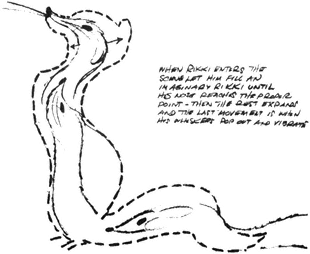
seconds.) And, "When Rikki leaves the scene, follow the angle of his pose. Hold tail until head is well out—then snap tail along path and out." Discussing this during a 1977 phone call, Jones drew on two interesting analogies. Envision, he said, a string of fifteen cars stopped by a red light. When the light changes, the fifteen cars won't move off en bloc . No, car i must move ahead several feet before car 2 can even start moving, likewise car 3, car 4 . . . So the string lengthens as it gets into motion. Or imagine that when a horse goes over a jump, the neck must move part way before it can start dragging the shoulders, then the shoulders must make some progress before they can drag the torso. Again, an effect of elongation. But, beginning at the moment the front feet hit the ground, the opposite occurs: the horse shortens as fluent movement comes piling up against blockage. Different parts a-move at different rates, that's a principle vital to convincing animation, also something Jones expected his staff to understand. And in-betweeners draw most of the frames where
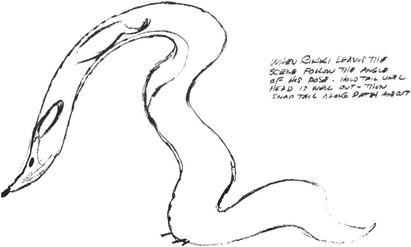
such things happen, one reason good in-betweening cannot be mechanized.
He's also used the cars-at-stoplight analogy to discuss the Coyote's formulaic fall. Wile E.'s torso drops away, leaving a stressed face atop a stretched-out neck. Two seconds later the contracting neck snaps the face down out of sight, leaving two long ears. When those in turn vanish we are left to ponder—oh, the reluctance of Being to succumb to Mutability.
Jones dissociates processes into parts so habitually it's doubtful if he's always aware that's what he's doing. "The Wedge," he said one day, apropos of a time when he was serving as Vice President for Children's Programming at ABC. (And Johnny Carson once said that being a Vice President at ABC is like being dancing master at Forest Lawn.[13] The Wedge (one of Isaac Newton's six Simple Machines) was
[13] A Los Angeles cemetery, if you've forgotten. It inspired Evelyn Waugh's The Loved One .
the theme of one film they made; and (said Jones) "When you start studying it you find there's so much there. If it wasn't for the Wedge we wouldn't have a saw. A saw is only a series of wedges." That's true, and it also says how a saw saws, by wedging bits of wood left and right so they crumble. You've spotted, surely, an Animation Director's habit of thought. What else is this piece of movement like? What can we break it down to? Decompose it to? (For that matter, what may some previous Animator have done with it? Jones credits a National Film Board of Canada production on the Wedge: I liked it and shamelessly used it.")
It's going to end up decomposed into drawings-per-second, but like Churchill's proverbial pudding, that decomposition will go better if it's ruled by a theme. The Saw-Wedge theme I don't know about, not having seen the NFB film. The Coyote's decomposition, it is safe to say, reflects a ritual reenactment of the death of Creativity; but paradoxically, at Termite Terrace, where it never died.
